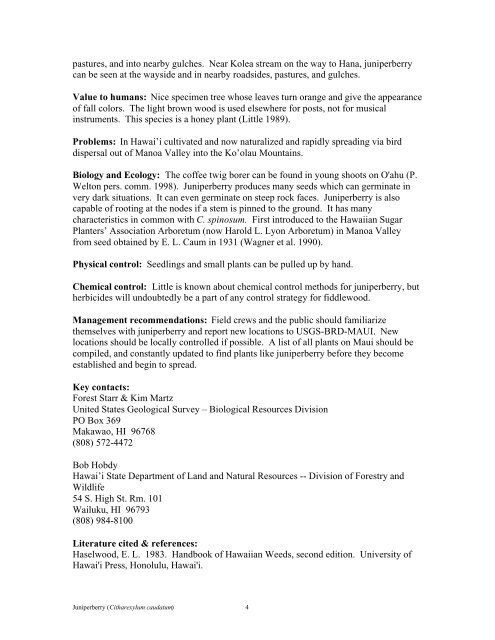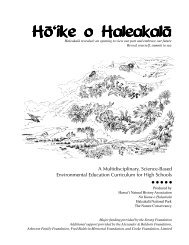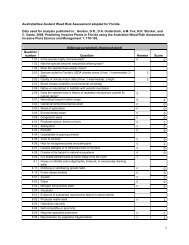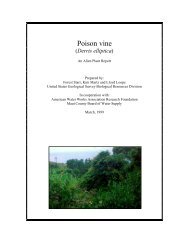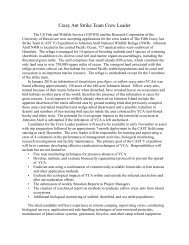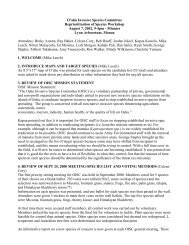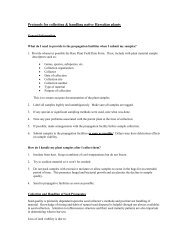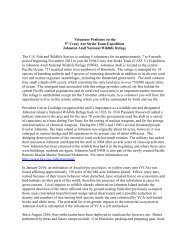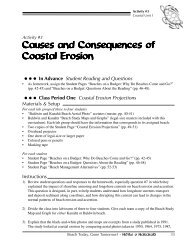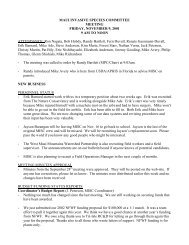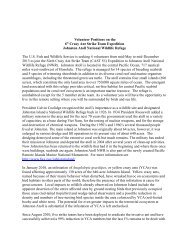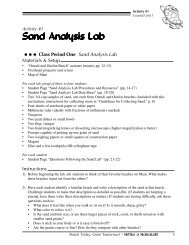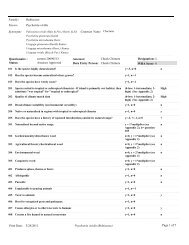(Citharexylum spinosum): an alien plant report - Hawaiian ...
(Citharexylum spinosum): an alien plant report - Hawaiian ...
(Citharexylum spinosum): an alien plant report - Hawaiian ...
Create successful ePaper yourself
Turn your PDF publications into a flip-book with our unique Google optimized e-Paper software.
pastures, <strong>an</strong>d into nearby gulches. Near Kolea stream on the way to H<strong>an</strong>a, juniperberry<br />
c<strong>an</strong> be seen at the wayside <strong>an</strong>d in nearby roadsides, pastures, <strong>an</strong>d gulches.<br />
Value to hum<strong>an</strong>s: Nice specimen tree whose leaves turn or<strong>an</strong>ge <strong>an</strong>d give the appear<strong>an</strong>ce<br />
of fall colors. The light brown wood is used elsewhere for posts, not for musical<br />
instruments. This species is a honey pl<strong>an</strong>t (Little 1989).<br />
Problems: In Hawai’i cultivated <strong>an</strong>d now naturalized <strong>an</strong>d rapidly spreading via bird<br />
dispersal out of M<strong>an</strong>oa Valley into the Ko’olau Mountains.<br />
Biology <strong>an</strong>d Ecology: The coffee twig borer c<strong>an</strong> be found in young shoots on O'ahu (P.<br />
Welton pers. comm. 1998). Juniperberry produces m<strong>an</strong>y seeds which c<strong>an</strong> germinate in<br />
very dark situations. It c<strong>an</strong> even germinate on steep rock faces. Juniperberry is also<br />
capable of rooting at the nodes if a stem is pinned to the ground. It has m<strong>an</strong>y<br />
characteristics in common with C. <strong>spinosum</strong>. First introduced to the Hawaii<strong>an</strong> Sugar<br />
Pl<strong>an</strong>ters’ Association Arboretum (now Harold L. Lyon Arboretum) in M<strong>an</strong>oa Valley<br />
from seed obtained by E. L. Caum in 1931 (Wagner et al. 1990).<br />
Physical control: Seedlings <strong>an</strong>d small pl<strong>an</strong>ts c<strong>an</strong> be pulled up by h<strong>an</strong>d.<br />
Chemical control: Little is known about chemical control methods for juniperberry, but<br />
herbicides will undoubtedly be a part of <strong>an</strong>y control strategy for fiddlewood.<br />
M<strong>an</strong>agement recommendations: Field crews <strong>an</strong>d the public should familiarize<br />
themselves with juniperberry <strong>an</strong>d <strong>report</strong> new locations to USGS-BRD-MAUI. New<br />
locations should be locally controlled if possible. A list of all pl<strong>an</strong>ts on Maui should be<br />
compiled, <strong>an</strong>d const<strong>an</strong>tly updated to find pl<strong>an</strong>ts like juniperberry before they become<br />
established <strong>an</strong>d begin to spread.<br />
Key contacts:<br />
Forest Starr & Kim Martz<br />
United States Geological Survey – Biological Resources Division<br />
PO Box 369<br />
Makawao, HI 96768<br />
(808) 572-4472<br />
Bob Hobdy<br />
Hawai’i State Department of L<strong>an</strong>d <strong>an</strong>d Natural Resources -- Division of Forestry <strong>an</strong>d<br />
Wildlife<br />
54 S. High St. Rm. 101<br />
Wailuku, HI 96793<br />
(808) 984-8100<br />
Literature cited & references:<br />
Haselwood, E. L. 1983. H<strong>an</strong>dbook of Hawaii<strong>an</strong> Weeds, second edition. University of<br />
Hawai'i Press, Honolulu, Hawai'i.<br />
Juniperberry (<strong>Citharexylum</strong> caudatum) 4


